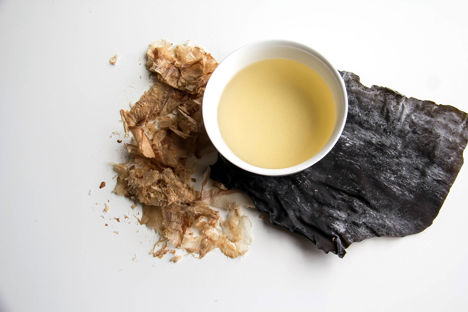
Flavours of Japan: dashi
Dashi is featuring increasingly on menus with the rise in popularity of Japanese cuisine. Rosana McPhee gives us the rundown on this classic stock, which is truly unique in flavour and impact.
Flavours of Japan: dashi
Dashi is featuring increasingly on menus with the rise in popularity of Japanese cuisine. Rosana McPhee gives us the rundown on this classic stock, which is truly unique in flavour and impact.
Dashi is a clear Japanese stock, perhaps the most important, definitive flavour of Japanese cuisine. Have a browse through any Japanese cookbook, and over and over again you’ll find dashi listed as a key ingredient. While the importance of stock in western cuisine cannot be underestimated – think about all of those French mother sauces that rely on a veal or beef stock that has been lovingly bubbling away in a giant stock pot for hours – the sheer umami punch of dashi, with its uniquely oceanic flavour, gives Japanese dishes that distinctive something that makes the cuisine so uniquely delicious.
Dashi is actually a rather loose term for this stock, which can be made from a variety of different ingredients depending on the type of flavour you want to imbue in your dishes. The very heart of dashi, it is often argued, lies in dried bonito flakes, which come from skipjack tuna that has been dried, smoked and fermented until it resemble small blocks of wood. Although this may not sound all too appetising, the beautiful pinkish flakes are the umami heart of dashi.
The second key dashi ingredient is kombu, a type of Japanese kelp which resembles very dark leather, and comes in large flat sheets. This provides the hit of seaside flavour to your dashi, which again packs in more of that umami taste. You can make a vegan dashi stock just by soaking kombu in water, but the most common magic combination is that of bonito and kombu.
There are some other key ingredients you’ll often find in dashi. For example, if you want a vegetarian stock for a dish, shiitake mushrooms are often used in place of the bonito flakes. They are also packed with umami flavour but add a wonderfully earthy edge to the stock. To enhance the seaside flavour of dashi, dried sardines, also known as niboshi, are also often added for a truly unique flavour.
The origins of dashi
Dashi was said to have been invented in the 1600s when people gathered their leftover mushrooms and boiled them with their stems and skins still on. Onions, herbs, cloves, and roasted meat was added to the mix and then seasoned with salt. Once it was ready, they put the broth through a strainer and placed it in a pan for further use.
In the 1800s, the concept of a ‘global stock’ was born. This is the same principle that governs all sauces and soups today, where stocks are used to make soups instead of just water. General stocks are often made with veal, beef, or any fresh bones and meat.
While western-style stocks rely heavily on meat and vegetables for flavour, dashi uses minimal ingredients that are packed full of flavour for a clean yet complex finish.
How to use dashi in cooking
Once you’ve mastered the art of dashi, the limits in its uses are only dictated by your imagination. Of course, you could use it to flavour soups and stews, where it can be adapted to your main ingredients – for example, what could be a better match to beef than a beautifully earthy mushroom dashi? Or a fish stew flavoured with niboshi dashi for an extra hit of the seaside?
Dashi can also be used to pack more flavour into your rice dishes. Sake no Hana chef Hideki Hiwatashi uses a potent mushroom dashi for his kamameshi, or ‘kettle rice’, which he then flavours with sake, soy sauce and fresh truffle for a wonderfully intense flavour.
Western chefs have also been quick to jump on the unique qualities of dashi. Daniel Clifford’s dashi jelly recipe makes a beautiful accompaniment to fresh prawns and a pea velouté, proving how adaptable this stock is to traditionally western flavours and techniques, while Phil Fanning riffs on some key components of dashi, kombu and shiitake, using them to add a punchy flavour to a more classical langoustine stock in his cured sea trout recipe.


